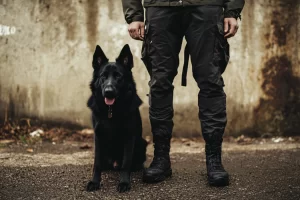Using a Leash Inside the House To Better Training Your German Shepherd Puppy
Training Your German Shepherd Puppy
Training a German Shepherd puppy can be a rewarding yet challenging task. One effective strategy that many dog trainers and behaviorists recommend is the use of a leash inside the house. This method not only aids in instilling good behavior but also strengthens the bond between the puppy and its owner. Using a leash inside the house allows for enhanced supervision and control over the puppy’s movements. German Shepherd puppies are known for their energy and curiosity, which can lead to destructive behaviors if not properly managed. A leash provides the owner with the ability to immediately correct undesirable behaviors such as chewing on furniture, jumping on guests, or getting into trash. This immediate correction helps the puppy understand which behaviors are unacceptable, promoting quicker learning and better behavior overall (Bailey, 2008). Leashing the puppy inside the house also ensures its safety by preventing access to dangerous areas, ingestion of harmful objects, or injuries from falls or other accidents (Horwitz, 2002).
House Training Your German Shepherd Puppy
House training is one of the most critical aspects of raising a German Shepherd puppy, and a leash can be an invaluable tool in this process, particularly for German Shepherd puppies, who can be strong-willed and independent. Using a leash helps in establishing a routine for potty breaks by guiding the puppy to a designated potty area at regular intervals. This practice teaches the puppy where and when it is appropriate to relieve itself (Lindsay, 2005). Additionally, keeping the puppy on a leash indoors reduces the likelihood of indoor accidents, as the owner can quickly take the puppy outside if it shows signs of needing to go (Campbell, 1975). Socialization is another crucial component of a puppy’s development, and a leash can facilitate positive socialization within the home environment. It allows for controlled introductions to new people, pets, and environments, ensuring that these interactions are positive and not overwhelming for the puppy (Serpell, 2016). Leashed socialization helps build the puppy’s confidence by exposing it to new experiences in a controlled manner, which is essential for preventing fear and anxiety-related behaviors in the future (Overall, 1997).
Building Trust With Your German Shepherd Puppy
Using a leash indoors helps establish the owner as the leader and builds trust between your German Shepherd puppy and yourself, which is particularly important for German Shepherds, who thrive under clear leadership and guidance. A leash allows for clear communication between the owner and the puppy through gentle tugs and verbal commands, teaching the puppy to follow the owner’s lead (Fennell, 2002). This interaction also provides opportunities for bonding and developing trust, as the puppy learns to rely on the owner for direction and security, which is crucial for a strong owner-pet relationship (Donaldson, 1996). Many problem behaviors in puppies, such as excessive chewing, digging, and barking, stem from boredom, lack of supervision, and inadequate training. A leash can be an effective tool in mitigating these issues. By keeping the puppy on a leash, the owner can redirect destructive behaviors toward more appropriate activities, like playing with designated toys (Dunbar, 1998). Moreover, the leash allows the owner to quickly intervene and correct excessive barking, teaching the puppy to be quiet on command (Yin, 2009).
Obedience Training Your German Shepherd Puppy
Obedience training is fundamental for any dog, especially for breeds like the German Shepherd that are often used in working roles. A leash is an essential tool for reinforcing obedience commands. It helps in practicing basic commands such as sit, stay, and come, by keeping the puppy close and under control, allowing for consistent reinforcement (Miller, 2001). For more advanced training, such as heel or off-leash reliability, starting with a leash indoors ensures that the puppy learns these commands in a controlled environment before transitioning to more challenging outdoor settings (Pryor, 2002). Using a leash inside the house offers numerous benefits for training a German Shepherd puppy. It enhances supervision and control, facilitates house training, promotes positive socialization, establishes leadership and trust, reduces problem behaviors, and supports obedience training. At Czech Working Line we believe this method not only aids in shaping a well-behaved and well-adjusted dog but also strengthens the bond between the puppy and the owner.
Bibliography
1. Bailey, Gwen. *The Perfect Puppy: Take Britain’s Number One Puppy Care Book with You*. Hamlyn, 2008.
2. Campbell, William E. *Behavior Problems in Dogs*. American Veterinary Publications, 1975.
3. Donaldson, Jean. *The Culture Clash: A Revolutionary New Way of Understanding the Relationship Between Humans and Domestic Dogs*. Dogwise Publishing, 1996.
4. Dunbar, Ian. *Before and After Getting Your Puppy: The Positive Approach to Raising a Happy, Healthy, and Well-Behaved Dog*. New World Library, 1998.
5. Fennell, Jan. *The Dog Listener: Learning the Language of Your Best Friend*. HarperCollins, 2002.
6. Horwitz, Debra F. *Blackwell’s Five-Minute Veterinary Consult Clinical Companion: Canine and Feline Behavior*. Blackwell Publishing, 2002.
7. Lindsay, Steven R. *Handbook of Applied Dog Behavior and Training, Procedures and Protocols*. Vol. 3. Wiley, 2005.
8. Miller, Pat. *The Power of Positive Dog Training*. Howell Book House, 2001.
9. Overall, Karen L. *Clinical Behavioral Medicine for Small Animals*. Mosby, 1997.
10. Pryor, Karen. *Clicker Training for Dogs: A Step-by-Step Guide to Teaching New Skills the Positive Way*. Sunshine Books, 2002.
11. Serpell, James, ed. *The Domestic Dog: Its Evolution, Behavior, and Interactions with People*. Cambridge University Press, 2016.
12. Yin, Sophia. *Perfect Puppy in 7 Days: How to Start Your Puppy Off Right*. CattleDog Publishing, 2009.




